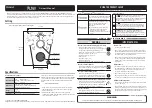
SWR-584C Instruction Manual
HF/VHF/220MHz SWR Analyzer
24
inductance through lead length or internal structure. For best accuracy with a variable load,
disconnect and check its value with a digital ohmmeter at the conclusion of the experiment.
However, never check load resistance with an ohmmeter with the analyzer connected -- the
results will be inaccurate and the meter's DC voltage could damage the detector diodes!
[ ] Connect the DUT cable to the analyzer and terminate the far end with your first trial load.
[ ] Tune the
VFO
up and down over a wide frequency span. Note the
Impedance changes
.
[ ] Try different terminations until the Impedance remains constant over the tuning range.
[ ] The resistance holding
Impedance
most constant is the line's characteristic impedance.
Important Warning: Never check the resistance of an adjustable load using an
ohmmeter if the analyzer is connected at the opposite end of the line!
7.5 Pre-adjusting Antenna Tuners
Using the SWR-584C to pre-adjust the impedance match through your station's tuner (ATU)
avoids exposing the transmitter PA to high-SWR loads and eliminates needless over-the-air
interference. The analyzer may be temporarily patched to the tuner's input using a short cable,
but many operators prefer to install a manual RF switch to facilitate rapid changeover. If you
choose to switch the analyzer, confirm:
•
Your switch has more than 50 dB of port Isolation
•
The wiper (or common) switch port is connected to the
Input Jack
of the tuner
•
There's no possible way for the analyzer to become connected to a transmitter.
To pre-adjust the tuner:
[ ] Patch or switch in the analyzer.
[ ] Tune the
VFO
to your target frequency and leave it there
[ ] Select the default
R&X
mode in the
Basic
menu.
[ ] Adjust the tuner controls until
SWR
indicators show 1.0 (or as close to 1:1 as possible).
[ ] Turn off and disconnect the SWR-584C
[ ] Reconnect the transmitter to the tuner.
7.6 Testing RF Transformers:
You can evaluate any RF transformer that has a termination
port between 25 and 100 Ohms available on one of its windings. Use only non-inductive
resistances for loads:
[ ] Connect the test port to the analyzer with a
very short
50-ohm pigtail (<1° phase shift).
[ ] Terminate all other port(s) with loads of the specified impedance.
[ ] Set the analyzer to the default
R&X
function in the
Basic
menu.
[ ] Sweep the
VFO
across the transformer's intended operating range.
Use
SWR, Resistance
(
R
)
Reactance
(
X
)
and
Impedance Magnitude
(
Z
) to evaluate the
transformer's impedance and useable bandwidth. To measure efficiency, compare the source





































